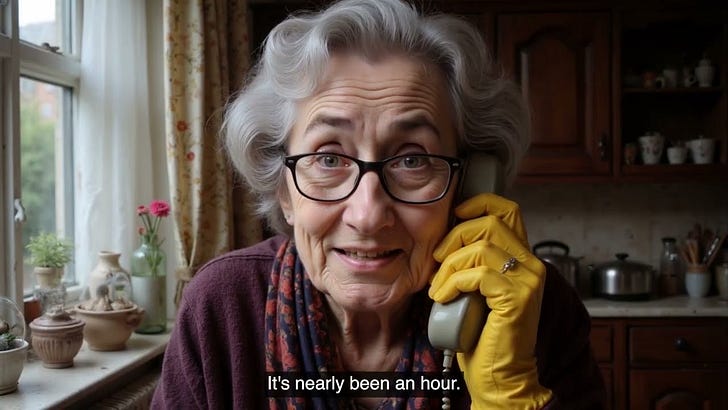When AI Cuts Backfire
CBA’s chatbot fiasco shows CEOs that real AI ROI depends on governance, sequencing, and augmentation, not cuts.
Commonwealth Bank’s voice-bot rollout triggered higher call volumes and a public reversal of 45 job cuts.
Yet the same bank is realising tangible ROI in fraud and scam reduction with human-in-the-loop AI.
The lesson for CEOs: sequence AI toward augmentation and bounded use cases before pursuing replacement.
In mid-2025, Australia’s largest bank moved to replace dozens of call-centre roles with a generative-AI “voice bot.” Early talking points promised fewer calls and leaner staffing; the narrative was sleek and self-assured, the sort of operational win that tempts any P&L owner facing cost pressure. But within weeks, the story swerved. Instead of relief, call volumes climbed, frontline managers were dragged back to the phones, and the bank found itself explaining to regulators, unions, and customers why “innovation” looked like poorer service.
By late August, Commonwealth Bank of Australia (CBA) executed a public U-turn, acknowledging an “error,” apologising to affected workers, and halting the cuts. The reversal wasn’t merely a stumble; it was a flashlight into how, and where, generative AI actually returns value in a complex, regulated service business. For CEOs, this is the case study to keep handy when the board asks, “Why aren’t we replacing more people with AI yet?”
The promise, the miss, the climb-down
The pitch was simple: the new voice assistant would handle routine calls, deflecting volume so remaining staff could focus on tougher inquiries. On paper, CBA initially cited reductions of roughly 2,000 calls per week. In reality, the system under-contained live demand. Workers reported overtime, and team leaders pulled into queues, the classic signs of broken hand-offs and poor escalation. Containment gains evaporated under operational stress, and a workplace dispute escalated the misclassification argument: these roles weren’t redundant after all. Within days, CBA reversed course and apologised.
The optics were ugly, but the structural lesson is pragmatic. Generative AI fails loudly when you start at the sharp end of customer experience in a high-stakes domain. Banking calls are identity-bound and emotionally charged; tolerance for error is low, and the hidden costs of rework, complaint handling, and reputational drag accumulate quickly. As CBA found, it’s not enough to tout a model’s task accuracy; you must validate net service outcomes in the wild, containment by intent, correct routing, complete context transfer to humans, and customer sentiment under live load.
Sequencing matters more than slogans
The same week the bank was fielding backlash, it also announced a multi-year partnership with OpenAI. That juxtaposition is instructive. Instead of abandoning AI, CBA redirected momentum to domains with clean feedback loops and measurable risk-reduction economics, scam and fraud prevention, internal augmentation, and staff tooling, where the model augments rather than replaces. This is where the ROI shows up first in regulated services: fewer reimbursements, faster interdiction, lower cost-to-serve on investigations, and steadier NPS.
CBA’s anti-scam push has been especially concrete. Across August updates, the bank reported a 76% reduction in customer scam losses from their 1H23 peak, driven by a generative-AI Scam Checker in its Truyu digital-identity app, new in-app verification for some transactions, and real-time intelligence from a “honeypot” network of AI bots that tie up scammers and feed signals back into defences. It’s a prototypical bounded domain: high signal-to-noise, short detection cycles, and clear cash outcomes. Has CBA implemented Daisy for real?
Why the same AI can fail in one place and pay off in another
In frontline call automation, the costs of partial correctness are socialised across your operation. Every misconstrued intent, brittle hand-off, or ambiguous identity step can ripple into longer handle times, repeated contacts, and complaints. In fraud and scam prevention, by contrast, even imperfect models generate asymmetry: a single interdicted event avoids reimbursements, fines, and complaint cascades, and the model learns with every adversarial probe it absorbs. The intelligence is cumulative; the stakes, while high, are bounded by controls; and the failure modes are managed by layered human review.
That doesn’t mean scam prevention is easy. It demands data access across channels, cross-industry coordination, and sustained investment. But the unit economics are visible and legible to a board, especially when you can attribute avoided losses and show a downward trend in reimbursements. CBA leaned into that, pairing model capability with controls, staff training, and vendor partnerships that emphasise augmentation over substitution.
What a CEO should copy and avoid
First, copy the sequencing. Start where feedback loops are fast and metrics are unambiguous: fraud and scam interdiction, agent-assist for complex work, KYC document checks, and post-interaction summarisation. These workflows are bounded and instrumentable, so you can separate hype from cash. CBA’s arc, from botched replacement to deeper investment in scam defences and human-in-the-loop tooling, shows that re-targeting AI toward augmentation can convert political heat into measurable wins.
Second, don’t cut people based on slide-deck containment. Demand a live-ops truth set before reductions: net containment by intent, escalation accuracy, context completeness, and sentiment change, measured over multiple traffic mixes, not a single A/B slice. Bake in “stop conditions” with staff representatives so you can pause or revert without a public tribunal. CBA’s reversal makes clear that the reputational and legal tax of getting this wrong can exceed the payroll savings you hoped to bank.
Third, reframe ROI beyond headcount. In the right domains, returns show up as avoided losses, fewer regulatory headaches, and lower cost-to-serve on high-friction processes. CBA’s scam-loss trend and ongoing OpenAI partnership telegraph a path many banks — and, by analogy, any regulated service business — can follow without torching customer trust.
The sober conclusion
CBA’s misfire wasn’t inevitable; it was a sequencing error wrapped in governance gaps. When a generative system meets the messy edges of human service, replacement-first strategies magnify risk. When the same technology meets bounded risk domains with human supervision, it compounds advantage. CEOs don’t need another puff piece about AI “transforming everything.” They need a playbook for where to point it first, how to measure live outcomes before making cuts, and how to turn early stumbles into durable gains. This is that playbook, written the hard way—on the switchboards of Australia’s biggest bank.
References
ABC News. (2025, August 21). Commonwealth Bank backtracks on AI job cuts, apologises for ‘error’ as chatbot lifts call volumes. https://www.abc.net.au/news/2025-08-21/cba-backtracks-on-ai-job-cuts-as-chatbot-lifts-call-volumes/105679492
Belanger, A. (2025, August 21). Bank forced to rehire workers after lying about chatbot productivity, union says. Ars Technica. https://arstechnica.com/tech-policy/2025/08/bank-forced-to-rehire-workers-after-lying-about-chatbot-productivity-union-says/
Finextra. (2025, August 11). CommBank reports 76% drop in scam losses as new security features rolled out. https://www.finextra.com/newsarticle/46427/commbank-reports-76-drop-in-scam-losses-as-new-security-features-rolled-out
Glover, A. (2025, August 21). Commonwealth Bank walks back decision to cut 45 call centre jobs to make room for AI chatbot. 9News. https://www.9news.com.au/national/commonwealth-bank-reverses-decision-to-cut-customer-service-jobs-to-make-room-for-chatbot/7d54b66a-36c9-44e4-8008-d19718f94b0b
Retail Banker International. (2025, August). CommBank partners with OpenAI on gen-AI banking services. https://www.retailbankerinternational.com/news/commbank-openai-on-gen-ai-banking/
Reuters. (2025, July 28). Australian lender CBA to cut 45 jobs in AI shift, draws union backlash. U.S. News & World Report. https://money.usnews.com/investing/news/articles/2025-07-28/australian-lender-cba-to-cut-45-jobs-in-ai-shift-draws-union-backlash
Sharwood, S. (2025, August 22). Bank reverses decision to replace 45 staff with chatbot. The Register. https://www.theregister.com/2025/08/22/commonwealth_ban_chatbot_fail_rehiring/
Commonwealth Bank of Australia. (2025, August 13). CommBank and OpenAI embark on Australia-first strategic partnership to advance AI solutions. https://www.commbank.com.au/articles/newsroom/2025/08/tech-ai-partnership.html
Commonwealth Bank of Australia. (2025, June 27). CommBank harnesses near real-time, AI-powered intelligence to outsmart the scammers (Apate.ai). https://www.commbank.com.au/articles/newsroom/2025/06/apate-ai.html
Martin, M. (2025, August 12). CBA scam losses drop 76% as AI tool and in-app verification roll out. Australian Broker News. https://www.brokernews.com.au/news/breaking-news/cba-scam-losses-drop-76-as-ai-tool-and-inapp-verification-roll-out-287772.aspx




